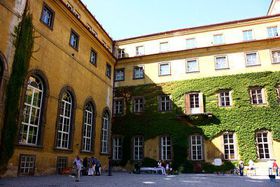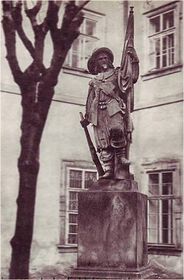Křižovnická Street, Karlova Street, Mariánské Square, Old Town
 Klementinum was the former Jesuit college which stretches out over five courtyards and includes three churches: the St Clemence’s Church built according to plans by Kilian Ignaz Dientzenhofer, the Welsche Kapelle (Vlašská kaple, the Foreigners’ Chapel) of the Italian Congregation and the St Salvator Church facing onto Crusaders’ Square (Křižovnické náměstí). Emperor Ferdinand 1st of Habsburg had called the Jesuits to Prague in the year 1556 in order to anchor a firm Catholic counterweight in the city against the strong Protestant currents emanating from the Reformation.
Klementinum was the former Jesuit college which stretches out over five courtyards and includes three churches: the St Clemence’s Church built according to plans by Kilian Ignaz Dientzenhofer, the Welsche Kapelle (Vlašská kaple, the Foreigners’ Chapel) of the Italian Congregation and the St Salvator Church facing onto Crusaders’ Square (Křižovnické náměstí). Emperor Ferdinand 1st of Habsburg had called the Jesuits to Prague in the year 1556 in order to anchor a firm Catholic counterweight in the city against the strong Protestant currents emanating from the Reformation.
 Soon after the Thirty Years’ War the corner stone for the Clementinum was laid, Emperor Ferdinand 3rd contributing the greatest amount of money for the building costs. As a Catholic-Jesuit institution of higher learning, the Clementinum was intended to represent a powerful force to balance the Charles University which leaned toward the Protestant Camp. After their order was dissolved in 1773 the Jesuits left the college and the Clementinum was reformed into the Seminary of the archbishopric.
Soon after the Thirty Years’ War the corner stone for the Clementinum was laid, Emperor Ferdinand 3rd contributing the greatest amount of money for the building costs. As a Catholic-Jesuit institution of higher learning, the Clementinum was intended to represent a powerful force to balance the Charles University which leaned toward the Protestant Camp. After their order was dissolved in 1773 the Jesuits left the college and the Clementinum was reformed into the Seminary of the archbishopric.
In 1777, the library of the former Jesuit college was merged with the material of the old college library of the Charles University and with the extensive library of the Count Kinsky and became the Public imperial, royal University Library. The library was an important repository for collecting the precious prints and books from the monasterial libraries that Emperor Josef 2nd had dissolved. From 1807 on it held the right to receive an obligatory copy of every work printed in Bohemian domains, for which reason it was continued as the University and National Library of the Czech Republic.
 Besides lectures in German studies Kafka attended lectures in art history and philosophy in the Clementinum. In addition, he could borrow books from the library’s holdings here or read them in the great reading hall. In one of the courtyards stands a monument from student history, the “Prague Student”, sculpted by the brothers Emanuel and Joseph Max and reminds the viewer of the defence of the city in 1648. This statue formed a popular motif for the German students of Prague and was often depicted on material like postcards printed for the German duelling fraternities.
Besides lectures in German studies Kafka attended lectures in art history and philosophy in the Clementinum. In addition, he could borrow books from the library’s holdings here or read them in the great reading hall. In one of the courtyards stands a monument from student history, the “Prague Student”, sculpted by the brothers Emanuel and Joseph Max and reminds the viewer of the defence of the city in 1648. This statue formed a popular motif for the German students of Prague and was often depicted on material like postcards printed for the German duelling fraternities.
